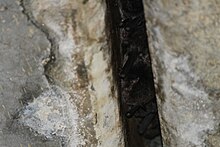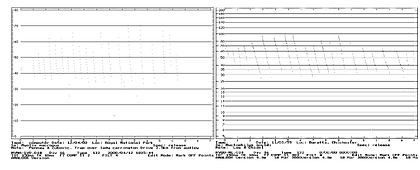Myotis macropus
| Southern myotis Large-footed myotis | |
|---|---|
 | |
| roosting under a bridge in Termeil (New South Wales, Australia) | |
Conservation status | |
| Scientific classification | |
| Domain: | Eukaryota |
| Kingdom: | Animalia |
| Phylum: | Chordata |
| Class: | Mammalia |
| Order: | Chiroptera |
| Family: | Vespertilionidae |
| Genus: | Myotis |
| Species: | M. macropus |
| Binomial name | |
| Myotis macropus (Gould, 1854) | |
The southern myotis[2] (Myotis macropus), also known as large-footed myotis,[1] is a species of vesper bat (Vespertilionidae) in genus Myotis.[3] The southern myotis is one of only two Australian "fishing" bats and feeds by trawling its specially adapted feet along the water's surface for aquatic invertebrates and fish.
Distribution
M. macropus is distributed along the east coast of Australia, from south-east Queensland to New South Wales[4] and Victoria. A smaller presence was also recorded along the coasts of other national territories.[5] It has been recorded west of the Great Dividing Range in the 1970s at a billabong in Boomanoomana State Forest, near Mulwala and the Murray River.
Conservation
M. macropus is listed on the New South Wales Threatened Species Act 1995, prior to its taxonomic split from Myotis adversus.
A decline in water quality and increased urbanisation have been linked to M. macropus exclusion from aquatic habitats. The species has been identified as vulnerable to heavy metal pollution and bioaccumulation.[6]
Diet
Using echolocation, M. macropus forage upon aquatic and terrestrial prey. Analysis of their scat has found their diet to consist of a wide range of taxa. Among these are fishes, Hymenoptera, Chironominae (non-biting midges), Culicidae (mosquitoes), Lepidoptera (primarily moths), Coleoptera, Notonectidae and Corixidae (water boatmen).[7]
Behaviour and reproduction
Echolocation and vocalisations

M. macropus has an unusually linear call. The starting frequency of the call is between 70 and 80 kHz before dropping to between 35 and 40 kHz. Complete calls have a "kink" halfway through at approximately 50 kHz, which often reoccurs before the call is terminated. The call of the M. macropus is similar to that of Nyctophilus, leading to confusion. Unlike other echolocating bats, there is little to no regional variation in terms of their call.
Maternity colonies
Emergence behaviour
References
- ^ a b Gorecki , V.; Pennay, M. (2021). "Myotis macropus". IUCN Red List of Threatened Species. 2021: e.T136697A22039960. doi:10.2305/IUCN.UK.2021-1.RLTS.T136697A22039960.en. Retrieved 19 November 2021.
- ^ NSW Office of Environment & Heritage. "Southern Myotis - profile". Retrieved 26 July 2023.
- ^ Myotis macropus in Mammal Species of the World
- ^ Myotis macropus profile and distribution map within New South Wales
- ^ Distribution map of Myotis macropus (ALA)
- ^ Clarke-Wood, Bradley K.; Jenkins, Kim M.; Law, Brad S.; Blakey, Rachel V. (2016). "The ecological response of insectivorous bats to coastal lagoon degradation". Biological Conservation (202): 10–19. Retrieved 26 July 2023.
- ^ Law B. and Urquhart C.A., 2000: Diet of the large-footed myotis Myotis macropus at a forest stream roost in northern New South Wales. Australian Mammalogy 22: 121-124
External links

 Data related to Myotis macropus at Wikispecies
Data related to Myotis macropus at Wikispecies
- Myotis macropus on the Atlas of Living Australia
- Myotis macropus on the Environment Department of New South Wales
- Myotis macropus classification on Animal Diversity Web
- v
- t
- e
- Kingdom: Animalia
- Phylum: Chordata
- Class: Mammalia
- Order: Chiroptera
- Family: Vespertilionidae
- Subfamily: Myotinae
- Large-footed bat (M. adversus)
- Southern myotis (M. aelleni)
- Silver-tipped myotis (M. albescens)
- Myotis alcathoe (M. alcathoe)
- Szechwan myotis (M. altarium)
- Anjouan myotis (M. anjouanensis)
- Annamit myotis (M. annamiticus)
- M. annatessae
- Hairy-faced bat (M. annectans)
- Atacama myotis (M. atacamensis)
- Peters's myotis (M. ater)
- Sir David Attenborough's myotis (M. attenboroughi)
- Southwestern myotis (M. auriculus)
- Australian myotis (M. australis)
- Southeastern myotis (M. austroriparius)
- Chestnut myotis (M. badius)
- M. bartelsi
- Bechstein's bat (M. bechsteinii)
- Lesser mouse-eared bat (M. blythii)
- Rufous mouse-eared bat (M. bocagii)
- Far Eastern myotis (M. bombinus)
- Brandt's bat (M. brandtii)
- Bocharic myotis (M. bucharensis)
- California myotis (M. californicus)
- Long-fingered bat (M. capaccinii)
- Chilean myotis (M. chiloensis)
- Large myotis (M. chinensis)
- Western small-footed bat (M. ciliolabrum)
- Guatemalan myotis (M. cobanensis)
- Cryptic myotis (Myotis crypticus)
- Csorba's mouse-eared bat (M. csorbai)
- Pond bat (M. dasycneme)
- Daubenton's bat (M. daubentonii)
- David's myotis (M. davidii)
- Kock's mouse-eared bat (M. dieteri)
- M. diminutus
- Dominican myotis (M. dominicensis)
- Elegant myotis (M. elegans)
- Geoffroy's bat (M. emarginatus)
- M. escalerai
- Long-eared myotis (M. evotis)
- M. fimbriatus
- Findley's myotis (M. findleyi)
- M. flavus
- Hodgson's bat (M. formosus)
- Cinnamon myotis (M. fortidens)
- Fraternal myotis (M. frater)
- Gomantong myotis (M. gomantongensis)
- Malagasy mouse-eared bat (M. goudoti)
- Gray bat (M. grisescens)
- Armenian whiskered bat (M. hajastanicus)
- M. handleyi
- Lesser large-footed bat (M. hasseltii)
- Herman's myotis (M. hermani)
- Horsfield's bat (M. horsfieldii)
- M. hyrcanicus
- Ikonnikov's bat (M. ikonnikovi)
- M. indochinensis
- Insular myotis (M. insularum)
- M. izecksohni
- Hairy-legged myotis (M. keaysi)
- Keen's myotis (M. keenii)
- Chinese water myotis (M. laniger)
- M. lavali
- Eastern small-footed myotis (M. leibii)
- Yellowish myotis (M. levis)
- Kashmir cave bat (M. longipes)
- Little brown bat (M. lucifugus)
- Eastern long-fingered bat (M. macrodactylus)
- M. macropus
- Pallid large-footed myotis (M. macrotarsus)
- Schwartz's myotis (M. martiniquensis)
- Dark-nosed small-footed myotis (M. melanorhinus)
- M. midastactus
- Maluku myotis (M. moluccarum)
- Burmese whiskered bat (M. montivagus)
- Morris's bat (M. morrisi)
- Wall-roosting mouse-eared bat (M. muricola)
- Greater mouse-eared bat (M. myotis)
- Whiskered bat (M. mystacinus)
- Natterer's bat (M. nattereri)
- Curacao myotis (M. nesopolus)
- Black myotis (M. nigricans)
- Nimba mountain bat (M. nimbaensis)
- Nepal myotis (M. nipalensis)
- M. nyctor
- Arizona myotis (M. occultus)
- Singapore whiskered bat (M. oreias)
- Montane myotis (M. oxyotus)
- Peninsular myotis (M. peninsularis)
- Beijing mouse-eared bat (M. pequinius)
- Eastern water bat (M. petax)
- M. phanluongi
- Flat-headed myotis (M. planiceps)
- Frosted myotis (M. pruinosus)
- Felten's myotis (M. punicus)
- Rickett's big-footed bat (M. ricketti)
- Ridley's bat (M. ridleyi)
- Riparian myotis (M. riparius)
- Thick-thumbed myotis (M. rosseti)
- Red myotis (M. ruber)
- Schaub's myotis (M. schaubi)
- Scott's mouse-eared bat (M. scotti)
- Northern long-eared bat (M. septentrionalis)
- M. sibiricus
- Mandelli's mouse-eared bat (M. sicarius)
- Himalayan whiskered bat (M. siligorensis)
- Velvety myotis (M. simus)
- Indiana bat (M. sodalis)
- Kei myotis (M. stalkeri)
- M. taiwanensis
- Fringed myotis (M. thysanodes)
- Cape hairy bat (M. tricolor)
- Cave myotis (M. velifer)
- M. vivesi
- Long-legged myotis (M. volans)
- Welwitsch's bat (M. welwitschii)
- Yanbaru whiskered bat (M. yanbarensis)
- Yuma myotis (M. yumanensis)
- Zenati myotis (Myotis zenatius)
- S. caliginosus
- Taiwan broad-muzzled myotis (S. latirostris)
- S. moupinensis













